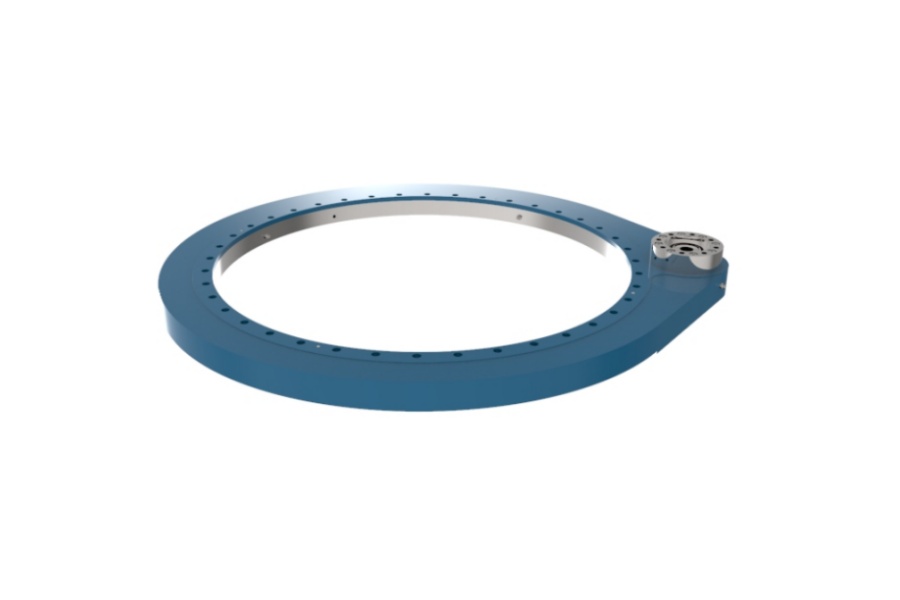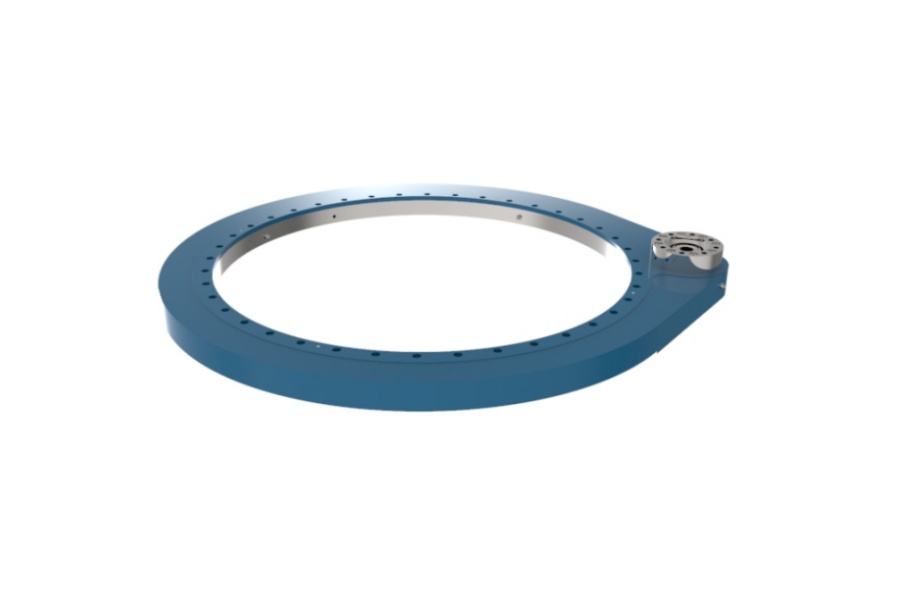
Slew Drive Backlash in Automation Equipment Applications
What is a Slew Drive
A Slew Drive is an integrated mechanical power transmission component that combines a slewing ring bearing with a worm gear reduction mechanism into a single compact unit. This engineered system facilitates controlled rotational movement about a single axis while simultaneously supporting substantial combined axial, radial, and moment loads. The fundamental design consists of a hardened worm screw that precisely engages with a gear teeth pattern machined into the slewing ring's raceway. When rotational power is applied to the worm input—typically from servo motors, stepper motors, or hydraulic motors—it drives the large diameter ring gear with a significant reduction ratio, producing high output torque with precise positional control. The completely enclosed nature of the system provides protection against contaminants while retaining essential lubrication. This integration makes slew drives particularly valuable for automation applications where space constraints, reliability requirements, and precision positioning capabilities are critical design considerations for successful system implementation.

Gear Backlash in Automation Applications
Gear backlash, defined as the angular movement between mating gear teeth when reversing direction, represents a critical performance parameter in automation equipment applications. In high-precision automation systems, excessive backlash directly compromises positioning accuracy and repeatability. Industrial robots, CNC machining centers, and automated assembly systems require extremely precise motion control to maintain tight manufacturing tolerances. When a slew drive exhibits significant backlash, the output position deviates from the commanded position during direction changes, resulting in positioning errors that affect product quality and process reliability. This angular displacement between expected and actual positions becomes particularly problematic in applications requiring precise angular positioning, such as in automated optical inspection systems, precision welding cells, and semiconductor manufacturing equipment where even minute deviations can render processes ineffective or cause substantial quality issues.
The phenomenon of hysteresis and efficiency loss directly relates to backlash and torsional stiffness characteristics. Hysteresis describes the lag between input and output when changing direction, representing energy loss within the system. This effect occurs because the gear teeth must travel through the clearance space before establishing firm contact and transmitting torque effectively. Manufacturers who cannot provide detailed hysteresis curves often specify loss motion and stiffness variation as alternative parameters for evaluating drive performance. In continuous operation automation systems, this hysteresis effect reduces overall system efficiency and creates nonlinear behavior that complicates control system design and implementation, particularly in applications requiring frequent direction changes or precise path following capabilities.
Vibration and oscillation problems frequently originate from excessive backlash in automation systems. When automated equipment suddenly changes direction, stops, or starts, the impact of gear teeth engaging after moving through backlash space generates shock loads that propagate throughout the mechanical structure. These vibrations compromise system stability, reduce positioning accuracy, and negatively affect the equipment's ability to perform delicate operations requiring smooth motion profiles. The resulting oscillations can also lead to premature fatigue failure of mechanical components, electrical connection problems, and reduced lifespan of sensitive instrumentation mounted on or near the equipment. In precision automation environments, such vibrations often necessitate additional damping measures or structural reinforcements to maintain required performance levels.
Accelerated wear mechanisms represent another significant consequence of excessive backlash in automation applications. The repeated impact of gear teeth engaging after traversing the backlash space creates abnormal wear patterns that progressively degrade gear tooth geometry. This wear typically manifests as pitting, scoring, or abnormal wear patterns on the gear tooth flanks, which further increases backlash in a self-accelerating degradation cycle. The resulting wear debris contaminates the lubricating oil, creating abrasive compounds that accelerate bearing wear and further compromise system performance. For automation equipment operating in high-cycle applications with continuous direction changes, this wear progression can significantly reduce service intervals and increase maintenance costs while potentially causing unplanned production downtime for repairs and component replacements.
The control and manufacturing complexities associated with backlash management present substantial engineering challenges. Implementing effective backlash compensation in control algorithms requires sophisticated approaches that often need additional sensors and advanced software capabilities. These compensation strategies must account for variable mechanical clearance under different operating conditions, temperatures, and wear states. From a manufacturing perspective, achieving near-zero backlash levels requires exceptional precision in gear manufacturing, heat treatment processes, and assembly techniques. This precision manufacturing necessitates specialized equipment, rigorous quality control measures, and selective assembly processes that significantly increase manufacturing complexity and production costs while potentially affecting production throughput and delivery schedules.
Position control limitations imposed by backlash particularly affect automation applications requiring precise angular positioning. The angular discrepancy between expected and actual positions caused by backlash creates significant challenges for applications such as robotic pick-and-place operations, automated welding, precision assembly tasks, and optical alignment systems. When motion direction changes, the output side load position may vary depending on the direction of approach due to the angular clearance in the gear mesh. This positioning uncertainty often compels system designers to implement secondary position feedback systems on the output shaft, creating dual-loop control architectures that increase system complexity and cost while introducing additional potential failure points into the control system architecture.
Safety implications of excessive backlash extend beyond performance issues to encompass critical operational safety concerns. In collaborative robot applications and automated systems operating in human environments, predictable and precise motion control is essential for ensuring operator safety. Backlash-induced positioning errors can cause unexpected equipment behavior, potentially creating hazardous situations involving unexpected movements or positional inaccuracies that might lead to collisions or pinching hazards. Additionally, the reverse drive capability affected by backlash characteristics plays a crucial role in managing human-machine interactions, where low impedance and predictable behavior during external force applications are essential for safe operation in collaborative working environments.
Key Characteristics of Slew Drives
Slew drives possess distinctive characteristics that make them valuable for automation applications while presenting specific challenges regarding backlash management. Their high torque density enables compact design solutions capable of delivering substantial rotational force from relatively small package dimensions, allowing automation equipment designers to maximize performance within space-constrained environments. The integrated design philosophy combines multiple functional elements—including bearing support, gear reduction, and mounting structure—into a single sealed unit that reduces assembly complexity while improving overall system reliability. Precision positioning capability varies significantly among different quality tiers, with high-performance units offering minimal backlash characteristics suitable for applications demanding accurate angular positioning and repeatable motion control. The inherent self-locking capability of the worm gear design provides built-in load holding without requiring additional braking systems, enhancing safety while simplifying control requirements. Robust construction enables reliable operation in demanding industrial environments, with sealing options available for contaminated or washdown conditions commonly encountered in manufacturing settings. Flexible configuration possibilities include various mounting orientations, drive motor interfaces, and feedback system integrations that facilitate adaptation to specific automation requirements. The high stiffness of properly manufactured units ensures minimal deflection under load, maintaining precision even when handling substantial off-center loads typical in automation applications.
Broader Applications of Slew Drives
Beyond precision automation, slew drives serve critical functions across multiple industries where their backlash characteristics must be appropriately managed for each specific application. The renewable energy sector employs these drives in solar tracking systems where they precisely position photovoltaic panels to follow the sun's path, requiring careful backlash control to maintain tracking accuracy while supporting significant environmental loads. Construction equipment relies on slew drives for excavator upper structure rotation, crane boom positioning, and concrete pump operation where some backlash may be acceptable in exchange for higher load capacity and robustness. Wind energy applications utilize these components in yaw control systems that orient nacelles into the wind and pitch control systems that adjust blade angle for power optimization, requiring balanced backlash performance for both precision and reliability. The aerospace and defense sectors incorporate precision slew drives in radar antenna positioning, satellite communication systems, and weapon station aiming mechanisms that demand exceptional accuracy with minimal backlash. Marine and offshore applications include deck crane rotation, winch positioning, and equipment handling systems built to withstand corrosive environments, where backlash requirements must be balanced against durability considerations. Medical equipment manufacturers use specially engineered slew drives in CT scanner gantries, surgical robot positioning, and patient table adjustment mechanisms requiring smooth, quiet operation with minimal backlash. Transportation systems incorporate these drives in vehicle turntables, maintenance positioners, and material handling equipment that must operate with high reliability while managing backlash effects on positioning accuracy.
Factors Influencing Slew Drive Pricing
The pricing of slew drives is determined by multiple engineering and commercial considerations that significantly affect their backlash performance characteristics. Material selection profoundly impacts cost, with standard carbon steel constructions representing the most economical option while premium alloy steels and specialized case-hardening treatments necessary for minimal backlash applications command substantially higher pricing. Precision engineering requirements for backlash control represent a major cost factor, as achieving and maintaining tight tolerances necessitates advanced manufacturing equipment, specialized grinding processes, selective assembly techniques, and comprehensive quality control measures that all contribute to final pricing. Load capacity requirements directly influence price through material requirements, bearing size, and structural design complexity, with higher capacity units requiring more robust construction to maintain precision under load. Performance specifications for backlash, running accuracy, positional repeatability, and efficiency ratings significantly affect manufacturing processes and associated costs. Drive size and scale determine material volume requirements and manufacturing complexity, with larger diameter units requiring specialized processing equipment and more extensive quality verification processes. Sealing and protection requirements for specific environmental conditions (such as IP ratings for moisture and dust protection or special seals for chemical resistance) add components and assembly complexity that increase price. Ancillary components such as integrated high-resolution encoders, precision reduction gears, brakes, and special lubrication systems represent additional cost factors beyond the basic drive unit. Custom engineering for unique mounting configurations, special interface requirements, or application-specific modifications requires non-recurring engineering costs that significantly affect pricing, particularly for low-volume applications. Production volume dramatically influences unit cost through manufacturing efficiencies, with high-volume OEM orders benefiting from economies of scale not available for small-batch or prototype quantities. Quality certification requirements for specific industries (such as ISO standards or medical device certifications) necessitate additional testing, documentation, and quality assurance processes that contribute to overall cost while ensuring performance consistency.
Supplier of Slew Drive
LYRADRIVE has established itself as a proficient manufacturer and global supplier of high-performance slew drives for precision automation and industrial applications. The company's product range encompasses both standard catalog designs and custom-engineered solutions specifically tailored to address backlash control requirements in automated systems. Their technical expertise focuses on delivering drives with optimized precision characteristics, reliable operation under continuous duty cycles, and configurations that integrate seamlessly with automation control systems. LYRADRIVE provides comprehensive engineering support to help automation designers select appropriate drive configurations based on specific load, precision, and performance requirements. The company's manufacturing capabilities include advanced quality control processes to ensure consistent performance characteristics essential for automation equipment. For automation engineers seeking reliable rotational motion solutions with controlled backlash performance, LYRADRIVE offers technically capable products supported by appropriate application expertise and engineering consultation services.



